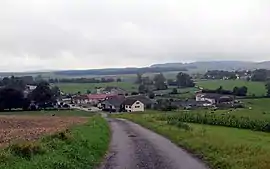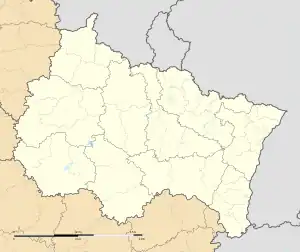Maroncourt | |
|---|---|
 A general view of Maroncourt | |
Location of Maroncourt | |
 Maroncourt  Maroncourt | |
| Coordinates: 48°14′59″N 6°09′25″E / 48.2497°N 6.1569°E | |
| Country | France |
| Region | Grand Est |
| Department | Vosges |
| Arrondissement | Épinal |
| Canton | Darney |
| Intercommunality | Mirecourt Dompaire |
| Government | |
| • Mayor (2020–2026) | Kevin Brégeot[1] |
| Area 1 | 2.24 km2 (0.86 sq mi) |
| Population | 6 |
| • Density | 2.7/km2 (6.9/sq mi) |
| Time zone | UTC+01:00 (CET) |
| • Summer (DST) | UTC+02:00 (CEST) |
| INSEE/Postal code | 88288 /88270 |
| Elevation | 276–338 m (906–1,109 ft) (avg. 280 m or 920 ft) |
| 1 French Land Register data, which excludes lakes, ponds, glaciers > 1 km2 (0.386 sq mi or 247 acres) and river estuaries. | |
Maroncourt (French pronunciation: [maʁɔ̃kuʁ] ⓘ) is a commune in the Vosges department in Grand Est in northeastern France.
Geography
Located a few kilometres to the south of Mirecourt and roughly fifteen kilometres (nine miles) to the west-north-west of Épinal, Maroncourt is the least populous commune in the department. It has no church, but falls within the parish of Hymont to the north.
Forest covers 71 of the commune's 224 hectares: the rest is devoted to agriculture.
The river Madon flows through the commune.
History
An early mention dates from 1159, when a charter addressed by the Bishop of Toul, Henry of Lorraine to the Abbey of Chaumousey confirms the gift of title to the Abbey of Maroncourt (Moiruncourt) made by Foulques of Saint-Vast and his wife Mélisende. The lands were still held by Chaumousey following a territorial consolidation that took place in 1595.
Population
| Year | Pop. | ±% p.a. |
|---|---|---|
| 1968 | 23 | — |
| 1975 | 21 | −1.29% |
| 1982 | 12 | −7.68% |
| 1990 | 16 | +3.66% |
| 1999 | 13 | −2.28% |
| 2007 | 11 | −2.07% |
| 2012 | 11 | +0.00% |
| 2017 | 9 | −3.93% |
| Source: INSEE[3] | ||
See also
References
- ↑ "Répertoire national des élus: les maires". data.gouv.fr, Plateforme ouverte des données publiques françaises (in French). 9 August 2021.
- ↑ "Populations légales 2021". The National Institute of Statistics and Economic Studies. 28 December 2023.
- ↑ Population en historique depuis 1968, INSEE